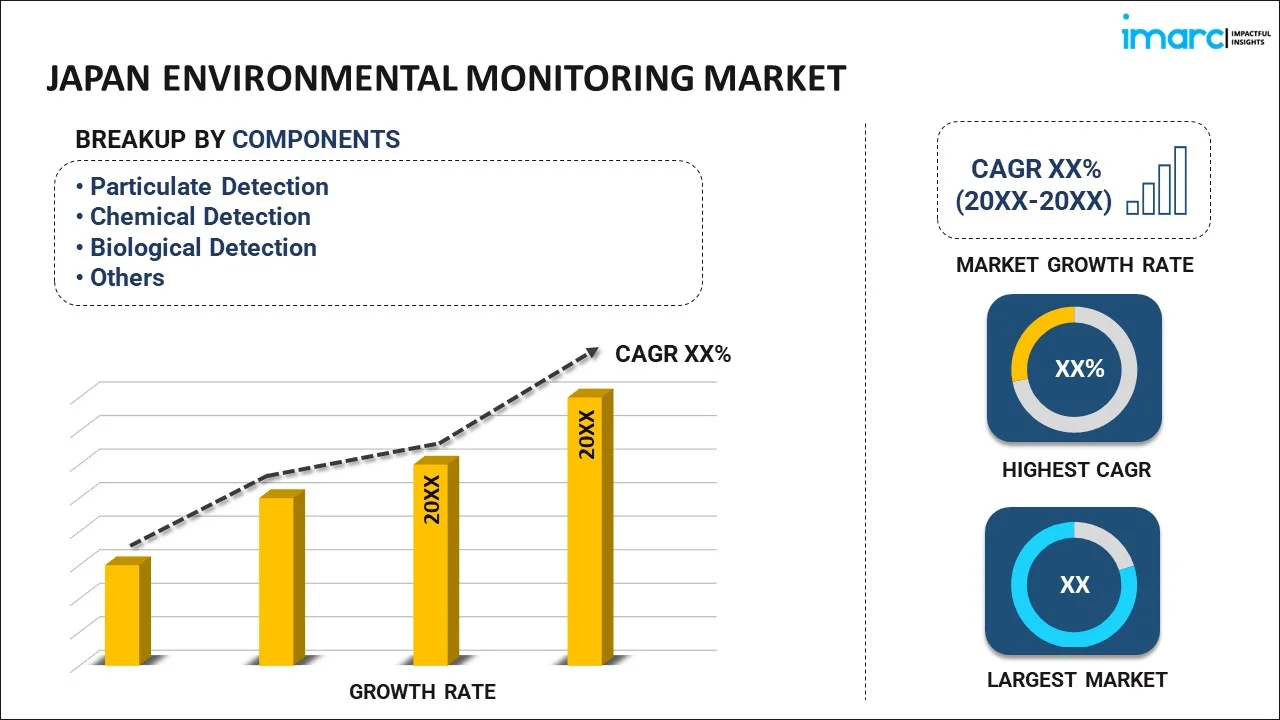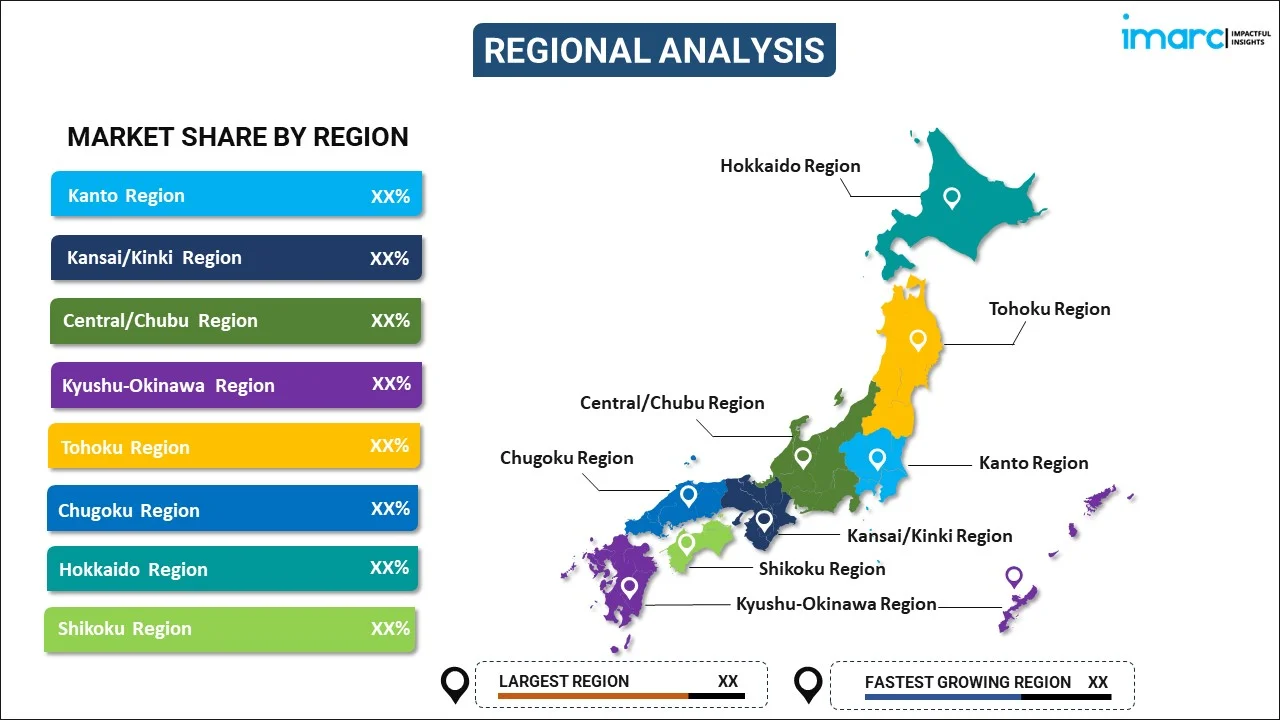
Japan Environmental Monitoring Market Report by Component (Particulate Detection, Chemical Detection, Biological Detection, Temperature Sensing, Moisture Detection, Noise Measurement), Product Type (Environmental Monitoring Sensors, Environmental Monitors, Environmental Monitoring Software, Wearable Environmental Monitors), Sampling Method (Continuous Monitoring, Active Monitoring, Passive Monitoring, Intermittent Monitoring), Application (Air Pollution Monitoring, Water Pollution Monitoring, Soil Pollution Monitoring, Noise Pollution Monitoring), and Region 2025-2033
Market Overview:
Japan environmental monitoring market size reached USD 920.4 Million in 2024. Looking forward, IMARC Group expects the market to reach USD 1,497.1 Million by 2033, exhibiting a growth rate (CAGR) of 5.7% during 2025-2033. Various technological innovations for comprehensive and effective monitoring solutions, coupled with the elevating need among organizations for measuring the overall impact of industrial activities on the environment to mitigate their adverse effects, are primarily driving the market growth.
|
Report Attribute
|
Key Statistics
|
|---|---|
|
Base Year
|
2024
|
|
Forecast Years
|
2025-2033
|
|
Historical Years
|
2019-2024
|
|
Market Size in 2024
|
USD 920.4 Million |
|
Market Forecast in 2033
|
USD 1,497.1 Million |
| Market Growth Rate 2025-2033 | 5.7% |
Environmental monitoring encompasses the use of diverse tools and methods to evaluate the influence of an activity on the environment. This entails a central hub for data management, validation for compliance checks, automated alerts for environmental monitoring, and quality control measures. Its applications extend to safeguarding public water supplies, overseeing the management of hazardous and radioactive waste, and pinpointing and analyzing sources of pollution. Additionally, environmental monitoring plays a crucial role in allocating resources for land planning and economic development, preserving endangered species, mitigating risks, and ensuring the protection of human health. Due to these multifaceted applications, environmental monitoring is gaining increased attention and recognition.
Japan Environmental Monitoring Market Trends:
The Japan environmental monitoring market is experiencing a positive upswing due to the escalating pollution levels, attributed to rapid urbanization and industrialization. Besides this, environmental monitoring plays a pivotal role in identifying and tracking changes in various parameters, including temperature, humidity, noise levels, biological and chemical air pollutants, and water quality, which is positively influencing the regional market. Moreover, governments of Japan are increasingly enforcing stringent regulations for monitoring and mitigating pollution, aligning with the growing concerns about health, rising mortality rates, and the imperative for improved resource management, thereby bolstering the market growth. Additionally, the reduced costs of wireless connectivity components and sensors contribute as a significant growth factor. The market is further propelled by advancements in wireless cellular and non-cellular communication technologies, allowing the deployment of environmental monitoring systems in remote and confined locations. These technologies facilitate effective tracking of water contamination and pollution levels, aiding in the establishment of environmental baseline standards. Additionally, the incorporation of big data analytics, advancements in sensor technology, and the development of Internet of Things (IoT)-specific cellular network connectivity solutions are anticipated to provide momentum to market growth over the forecasted period.
Japan Environmental Monitoring Market Segmentation:
IMARC Group provides an analysis of the key trends in each segment of the market, along with forecasts at the country level for 2025-2033. Our report has categorized the market based on component, product type, sampling method, and application.
Component Insights:

- Particulate Detection
- Chemical Detection
- Biological Detection
- Temperature Sensing
- Moisture Detection
- Noise Measurement
The report has provided a detailed breakup and analysis of the market based on the component. This includes particulate detection, chemical detection, biological detection, temperature sensing, moisture detection, and noise measurement.
Product Type Insights:
- Environmental Monitoring Sensors
- Environmental Monitors
- Environmental Monitoring Software
- Wearable Environmental Monitors
A detailed breakup and analysis of the market based on the product type have also been provided in the report. This includes environmental monitoring sensors, environmental monitors, environmental monitoring software, and wearable environmental monitors.
Sampling Method Insights:
- Continuous Monitoring
- Active Monitoring
- Passive Monitoring
- Intermittent Monitoring
The report has provided a detailed breakup and analysis of the market based on the sampling method. This includes continuous monitoring, active monitoring, passive monitoring, and intermittent monitoring.
Application Insights:
- Air Pollution Monitoring
- Water Pollution Monitoring
- Soil Pollution Monitoring
- Noise Pollution Monitoring
A detailed breakup and analysis of the market based on the application have also been provided in the report. This includes air pollution monitoring, water pollution monitoring, soil pollution monitoring, and noise pollution monitoring.
Regional Insights:

- Kanto Region
- Kansai/Kinki Region
- Central/ Chubu Region
- Kyushu-Okinawa Region
- Tohoku Region
- Chugoku Region
- Hokkaido Region
- Shikoku Region
The report has also provided a comprehensive analysis of all the major regional markets, which include Kanto Region, Kansai/Kinki Region, Central/ Chubu Region, Kyushu-Okinawa Region, Tohoku Region, Chugoku Region, Hokkaido Region, and Shikoku Region.
Competitive Landscape:
The market research report has also provided a comprehensive analysis of the competitive landscape. Competitive analysis such as market structure, key player positioning, top winning strategies, competitive dashboard, and company evaluation quadrant has been covered in the report. Also, detailed profiles of all major companies have been provided.
Japan Environmental Monitoring Market Report Coverage:
| Report Features | Details |
|---|---|
| Base Year of the Analysis | 2024 |
| Historical Period | 2019-2024 |
| Forecast Period | 2025-2033 |
| Units | Million USD |
| Scope of the Report | Exploration of Historical Trends and Market Outlook, Industry Catalysts and Challenges, Segment-Wise Historical and Future Market Assessment:
|
| Components Covered | Particulate Detection, Chemical Detection, Biological Detection, Temperature Sensing, Moisture Detection, Noise Measurement |
| Product Types Covered | Environmental Monitoring Sensors, Environmental Monitors, Environmental Monitoring Software, Wearable Environmental Monitors |
| Sampling Methods Covered | Continuous Monitoring, Active Monitoring, Passive Monitoring, Intermittent Monitoring |
| Applications Covered | Air Pollution Monitoring, Water Pollution Monitoring, Soil Pollution Monitoring, Noise Pollution Monitoring |
| Regions Covered | Kanto Region, Kansai/Kinki Region, Central/ Chubu Region, Kyushu-Okinawa Region, Tohoku Region, Chugoku Region, Hokkaido Region, Shikoku Region |
| Customization Scope | 10% Free Customization |
| Post-Sale Analyst Support | 10-12 Weeks |
| Delivery Format | PDF and Excel through Email (We can also provide the editable version of the report in PPT/Word format on special request) |
Key Questions Answered in This Report:
- How has the Japan environmental monitoring market performed so far and how will it perform in the coming years?
- What has been the impact of COVID-19 on the Japan environmental monitoring market?
- What is the breakup of the Japan environmental monitoring market on the basis of component?
- What is the breakup of the Japan environmental monitoring market on the basis of product type?
- What is the breakup of the Japan environmental monitoring market on the basis of sampling method?
- What is the breakup of the Japan environmental monitoring market on the basis of application?
- What are the various stages in the value chain of the Japan environmental monitoring market?
- What are the key driving factors and challenges in the Japan environmental monitoring?
- What is the structure of the Japan environmental monitoring market and who are the key players?
- What is the degree of competition in the Japan environmental monitoring market?
Key Benefits for Stakeholders:
- IMARC’s industry report offers a comprehensive quantitative analysis of various market segments, historical and current market trends, market forecasts, and dynamics of the Japan environmental monitoring market from 2019-2033.
- The research report provides the latest information on the market drivers, challenges, and opportunities in the Japan environmental monitoring market.
- Porter's five forces analysis assist stakeholders in assessing the impact of new entrants, competitive rivalry, supplier power, buyer power, and the threat of substitution. It helps stakeholders to analyze the level of competition within the Japan environmental monitoring industry and its attractiveness.
- Competitive landscape allows stakeholders to understand their competitive environment and provides an insight into the current positions of key players in the market.
Need more help?
- Speak to our experienced analysts for insights on the current market scenarios.
- Include additional segments and countries to customize the report as per your requirement.
- Gain an unparalleled competitive advantage in your domain by understanding how to utilize the report and positively impacting your operations and revenue.
- For further assistance, please connect with our analysts.
 Inquire Before Buying
Inquire Before Buying
 Speak to an Analyst
Speak to an Analyst
 Request Brochure
Request Brochure
 Request Customization
Request Customization




.webp)




.webp)












